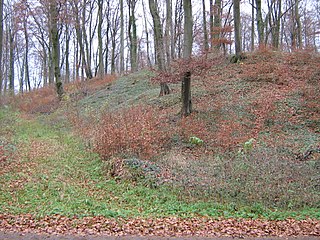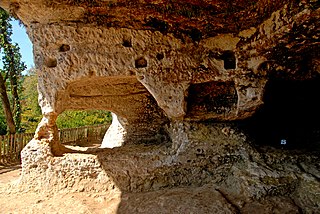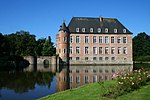Montaiglian, the first name of Aurignacian
Following the official web-site of Onhaye, The Belgian government commissioned in 1867 the geologist Édouard Dupont to study the caves (locally called trous, lit., "holes") located in the rocky spur of Montaigle. He named each of them after the trees growing near the cave's entrance; Trou du Sureau (Elder), Trou du Chêne (Oak), Trou de l'Erable (Maple), except the lowest one, named Trou Philippe after the name of the hermit who lived therein. Prehistoric remains were found in all of these caves; Dupont described the Cro-Magnon civilization years before the French paleontologists, but the French nomenclature was adopted, though. The "Montaiglian" layer was later renamed "Aurignacian", after the cave of Aurignac in the Pyrénées. [1] This opinion is also indirectly in a book of Marcel Otte [2] Hawthorne Harris Wilder wrote yet in 1924 Montaiglian (or Augniracian) [3]
In Gallo-Roman religion, Damona was a goddess worshipped in Gaul as the consort of Apollo Borvo and of Apollo Moritasgus.

The year 1908 in archaeology involved some significant events.
Naulette, French: Caverne de la Naulette is a large cave located in Wallonia on the left bank of the Lesse, a tributary of the Meuse in the hills above Dinant, Belgium.
Icovellauna was a Celtic goddess worshiped in Gaul. Her places of worship included an octagonal temple at Le Sablon in Metz, originally built over a spring, from which five inscriptions dedicated to her have been recovered, and Trier, where Icovellauna was honored in an inscription in the Altbachtal temple complex. Both of these places lie in the valley of the river Moselle of eastern Gaul in what are now Lorraine in France and Rhineland-Palatinate in Germany. One such inscription was, somewhat unusually, inscribed on a copper tablet in Roman cursive letters.

Blandas is a commune in the Gard department in southern France. It is known for its proximity to the Cirque de Navacelles and the town encompasses one of the principal overlooks on the Cirque. It is also known for its exceptional megalithic sites. It is included in the UNESCO world heritage site "The Causses and the Cévennes, Mediterranean agro-pastoral Cultural Landscape"

Celtic Luxembourg existed during the period from roughly 600 BC until 100 AD, when the Celts inhabited what is now the territory of the Grand Duchy of Luxembourg. Their culture was well developed, especially from the 1st century BC, as can be seen from the remains of the extensive Titelberg site in the far southwest of the country and from the impressive finds in several tombs and necropolises in the Moselle valley and its surroundings.

Genlis is a commune in the Côte-d'Or department in eastern France. The 20th-century archaeologist Jean Charbonneaux (1895–1969) was born in Genlis.

Triguères is a commune in the Loiret department in north-central France.

Lussac-les-Châteaux is a commune in the Vienne department in the Nouvelle-Aquitaine region in western France.

Roc-aux-Sorciers is an Upper Paleolithic rock shelter site dating to the mid-Magdalenian cultural stage, ca 14,000 yBP, made famous by its relief wall carvings. The site is in the French commune of Angles-sur-l'Anglin, in Vienne. The name 'Sorcerers' Rock', with its suggestions of pagan rendez-vous, was applied to the site long before the wall-carvings were discovered.

The archaeological site Abri de la Madeleine is a rock shelter under an overhanging cliff situated near Tursac, in the Dordogne département of the Aquitaine Région of South-Western France. It represents the type site of the Magdalenian culture of the Upper Paleolithic. The Bison Licking Insect Bite, a 20,000 year old carving of exceptional artistic quality, was excavated at the site. The shelter was also occupied during the Middle Ages. The medieval castle of Petit Marsac stands on the top of the cliff just above the shelter. An engraved bone rod from the cave, depicting a lioness licking the opening of either a gigantic human penis or a vulva, shows the first documented act of bestiality.

The Rock of Solutré is a limestone escarpment 8 km (5.0 mi) west of Mâcon, France, overlooking the commune of Solutré-Pouilly. It is an iconic site in the department of Saône-et-Loire, in Bourgogne-Franche-Comté. Protected by the French law on sites naturels classés and currently at the heart of a grand site national operation, it draws its fame severally as a rare geological phenomenon of the region, as a prehistoric site of the eponymous Solutrean paleolithic culture, and for the natural environment which its summit provides, the pelouse calciole grassland of Mâcon, with its distinctive flora and fauna. Occupied by man for at least 55,000 years, it is also the cradle of the Pouilly-Fuissé wine appellation. It has attracted media coverage since the 1980s when French President François Mitterrand started to make ritual ascents of the peak once per year.

Roger Agache was a French archaeologist. He was among the first to take part in aerial archaeology in France, and helped to develop a methodology for aerial prospecting.

The caves of Arcy-sur-Cure are a series of caves located on the commune of Arcy-sur-Cure, Burgundy, France. Some of them contained archaeological artefacts, from the Mousterian to Gallo-Roman times.

The Schmerling Caves are a group of caves located in Wallonia on the right bank of the stream called the Awirs, near the village of Awirs in Flémalle, Belgium. The caves are notable for their past fossil finds, particularly of hominins. They were explored in 1829 by Philippe-Charles Schmerling, who discovered, in the lower cave, the remains of two individuals, one of which, now known as Engis 2, was a fossil of the first Neanderthal ever found; the other was a Neolithic homo sapiens. Also known as Trô Cwaheur or Trou Caheur, this lower cave has since collapsed. A third cave was destroyed because of work on the adjacent quarry, the Ancienne Carrière des Awirs.
Georges Chenet was a French archeologist from Argonne who participated in excavation in Syria.

Augusta Hure was the first woman appointed to museum curator in France. She was nicknamed the "Master of Sénonais Archeology."

The Museum of Art and Archeology of Périgord, often abbreviated MAAP, is a municipal museum located in Périgueux. It is the oldest museum in the Dordogne department and it includes over 2,000 square metres of permanent exhibition.


















